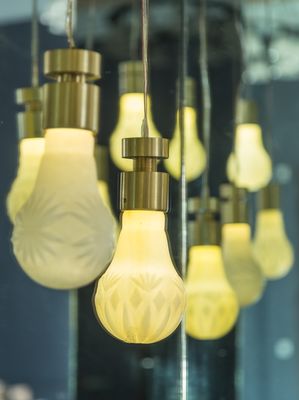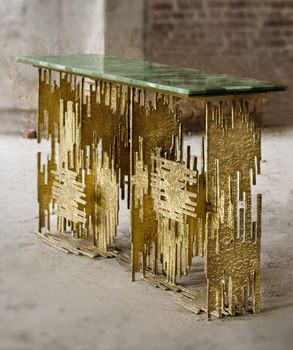He calls it '15,556'. An exquisite exhibition of 26 chairs, tables, benches, screens and lighting, '15,556' encapsulates architect Rooshad Shroff's research on design over the last five years. “The name of the exhibition denotes the number of man-hours that went into the making of this collection. It is an acknowledgment of the time and skill involved in creating these handcrafted products,” says Shroff, who has been pushing traditional craftsmen to create unexpected contemporary objects with an Indian soul.
One of the highlights of his recently concluded exhibition in Delhi were wooden chairs embroidered with zardozi and French knots, a technique that Shroff has patented. “In India, we have the luxury of having an abundance of craft at our disposal. However, it is treated more like a souvenir and has not been elevated to a new level,” says Shroff. “With the embroidered chairs [Rs 2.4 lakh], we have pushed the extremes for the craftsmen. The precision and expertise of the carpenters, too, was challenged. We also pushed geometric boundaries with marble carvings by making monolithic chunks of marble and creating bulbs out of them.”
 Bulbs carved out of monolithic chunks of marble—a Rooshad Shroff creation.
Bulbs carved out of monolithic chunks of marble—a Rooshad Shroff creation.
There was a time when Indians obsessed over importing furniture from Italy, rugs from Istanbul and antiques from Paris. Those with deep pockets hardly considered the Indian design labels to do up homes. However, with the growing desire to have something simple, elegant and exclusive, visionary homeowners are now turning to Indian designers with a strong sense of identity. “There was a period when plastic and fabrication techniques were huge, but now people are giving preference to natural, handmade products. Although 90 per cent of my clients are French, I hope, over time, Indians would appreciate the craft and its slow production,” says Shroff, who worked with architectural firms such as REX, New York, and Zaha Hadid Architects, London, before starting his own firm in Mumbai in 2011.
Encouraged by young, urban consumers who are willing to experiment with some edgy furniture designs, Gunjan Gupta presented the 'Kissa Kursi Ka—a chairy tale' at the Kochi-Muziris Biennale. Over the past decade, she has played around with the idea of sculptural chairs through various mediums. From the 'Aloo Bori' sofa set to the Gadda Chair to the Dining Throne, Gunjan's creations for the biennale traces the evolution of the chair in India. “Most people are done with elaborate interiors these days. They have an intelligent understanding of space and want statement pieces that define their personality. The combination of old and new works best for my clients. For instance, the Bori sofa is a textured installation of jute sacks filled with foam potatoes that are deceptively comfortable. People want an element of Indianness, which is not ethnic,” says Gunjan, who is widely popular for her seats and tables, consoles and coffee tables.
Mumbai-based Gauri and Mikhil Narang wanted their home to be a reflection of their lives, childhood, individuality and togetherness. So when they actually got down to doing up their ancestral home in Colaba, each corner was carefully developed to suit their lifestyle. “Mikhil wanted a home that reminded him of his life in Paris. So, we began with that thought and just kept developing further. With a combination of great craftsmanship, Victorian mouldings, old Burma teak and brass hardware, we were able to achieve what we wanted,” says Gauri, managing director, iPurple.
The Narangs' love for travel, too, is reflected in their vast repertoire of collectibles from the world over. “We bought art from emerging artists in Baroda, furniture including gull-wing chairs and our bed from local designers in Shanghai. Books, candles and table lamps [came] from Paris and Noritake tableware from Sri Lanka. We bought an antique finish bar from an Indian online store along with cushions and some artefacts from local boutiques in Mumbai. There is also a lot of good local talent doing custom-made and exclusive work that isn't expensive yet gives your home its own individuality,” says Gauri, who also developed her own colour scheme for certain rooms in the house.
At the Bombay Atelier, the Indian context is seen in a bright metal Namaste chair (Rs 16,000) with the traditional palm-together greeting and an Agarbatti table (060,000) with metal feet that resemble incense sticks. “I think when someone buys a Bombay Atelier piece, they buy into an ideology, a culture. So now we have people who accept we have a limited range of pieces with a thought process and system behind them,” says Farzin Adenwalla, founder, Bombay Atelier.
While the shift towards high-end homegrown design is at a nascent stage right now, most entrepreneurs feel the tastes of their Indian clients are at par with international connoisseurs. “Spaces are getting more interesting now,” says Vikram Goyal, founder of Viya Home. “My clients here appreciate very abstract, contemporary work, which is bought by western designers, too. They want anything but the ordinary. Their appreciation for design is new but encouraging.”
 Stand apart: Viya Home's Stalactite Console | Manav Parhawk
Stand apart: Viya Home's Stalactite Console | Manav Parhawk
TOP PICKS/ HOMES
VIYA HOME: Vikram and Divya Goyal's Viya Home is what the contemporary Indian fairy tale is made of. It is Indian and international. Always hearkening a period in design history, say, Art Deco, or giving African culture a nod with his Africa tables, or the Persepolis Wall Sconce, Viya has incredible furniture and objet d’art. The Stalactite Console is museum-worthy and can double as a slick bar, provided it's only Dom Pérignon you serve out of it.
PERIOD FURNITURE BY MAHENDRA DOSHI AND PHILLIPS ANTIQUES: Mahendra Doshi and Phillips Antiques are the doyens of vintage colonial furniture in India. Chiki Doshi from The House of Mahendra Doshi has an impeccable eye trained under his uncle Mahendra Doshi himself. As for Phillips Antiques, Farooq Issa needs little introduction with his beautiful flagship store right in the heart of Apollo Bunder. With an Aladdin's cave full of treasure, you can spot an antique Kerala Day Bed or Pierre Jeanneret Chandigarh Chairs.
CONTEMPORARY INDIAN ART: Contemporary Indian art is at the top of its game. Artists like Abir Karmakar, Aditi Singh, Avinash Veerarghavan, Dia Mehta Bhupal, Goutam Ghosh, Nandini Valli Muthiah, Neha Choksi, Raqs Media Collective, Rohini Devasher, Sahej Rahal, Sarnath Banerjee, Sandeep Mukherjee, Shilpa Gupta and Zakir Hussain are the new talents to look out for. The masters of the future are being created now.
JEAN-BAPTISTE CARPEAUX’S LE CHINOIS OR BUST OF A CHINESE MAN: The terracotta bust, a 1920–1939 cast of an 1872 design, is based on a much larger Carpeaux sculpture with figures representing the four continents and is now in the collection of the Musée d’Orsay in Paris.
NORITAKE CROCKERY: Noritake, originating in a village of the same name near Nagoya in Japan, has been a favourite with homes, hotel chains and airlines for its delicate designs and durable quality for over 100 years now. Its diverse product range and technologically superior projects have a worldwide appeal.






